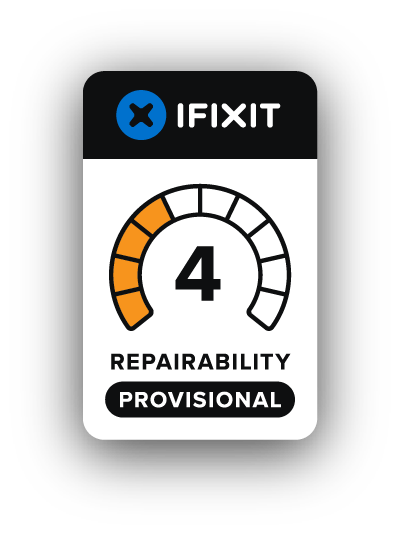Meta recently released their highly anticipated Quest 3 mixed reality headset, and we’ve given it the iFixit teardown treatment. Spoiler alert: It’s not super repairable, as you’ll see in the video below.
We’ve been taking apart VR headsets for seven years, digging into the guts of everything from the Oculus Rift CV1 to the PS VR 2. The technology has undoubtedly gotten better: The tracking is smoother, the environments are more interesting, and more and more players are jumping into the market to show us their vision of a virtual/augmented/mixed reality. But it seems like more and more often, repair is getting left off of designers’ priority lists.
And that’s why, instead of a blow-by-blow narrative of the Quest 3 teardown, I feel it’s more important that I try to explain why my company allows me to willfully destroy every electronic device I can get my hands on. To start, we need to talk about Apple and “the year of virtual reality”—a year that shaped up to be “the run-up to mixed reality.”

Apple’s highly anticipated Vision Pro mixed reality headset, which was announced in June 2023 but widely rumored to launch the same year, slipped to a Q1 2024 release schedule. This was supposedly due to production difficulties related to the manufacture of the cutting-edge micro-OLED panels.
Enter the current market leader in the virtual space: Meta. Like Apple, Meta’s CEO has long anticipated the revolutionary potential of virtual reality (VR) and mixed reality (MR) and has pumped billions of dollars into R&D to create the devices and platforms necessary to build that virtual world. Just like the iPhone elevated Apple to become the richest company in the world in eight short years, so too does Meta intend to capitalize on the VR and MR markets to achieve the same success.
Meta’s last attempt at derailing Apple’s plans to dominate this future market was with the Quest Pro. The seemingly rushed launch in October 2022 led to last-minute hardware cuts, a buggy and bland virtual environment, widespread reports of users returning their headsets, and ultimately a poor sales performance that resulted in the price of the headset being cut by a full one-third mere months after launch. Plus, it was a total nightmare to get into—absolutely terrible to repair.

It’s fair to say that things went awry, but Meta is not done. As the battle to dominate the narrative for the next multi-trillion-dollar electronic device category heats up, we’re trying to focus attention on how those billions of devices can avoid ending up in landfills.

This requires responsible and ethical decision-making at the earliest stages of the design process. Designing for repair is difficult, and we’re trying to bring that kind of decision-making to the fore through our reporting, support of legislation, education initiatives, partnerships with other advocacy organizations, and engagement with manufacturers. But more than anything, we try to get designers’ attention by taking apart their cool new stuff with an eye to how it’ll fare when it starts to break. Which it will.
That brings us back to our Quest 3 teardown, where we found the most immediate failure was the extremely complicated procedure of replacing the lithium polymer battery pack. Lithium-based batteries are disposable, as are all rechargeable batteries, and they can wear out in as little as 2 years. Being able to economically replace them is key to a device’s useful lifespan. Replacing the battery in the Quest 3 is as difficult as it was in the Quest 2, and far more difficult than the Quest Pro (though the Quest Pro had its own major design failures).

But it’s not all bad news. Meta decided to revert to easily accessible and replaceable batteries for the controllers. The batteries won’t last as long as the high-capacity lithium-ion cells in the Quest Pro, but you also don’t have to risk breaking your controller if the battery dies. That’s a win.

By drawing attention to these design flaws, our hope is that the engineers and product designers will factor it into their next iteration so that when that “iPhone moment” does arrive, we’ll already have repairability and reusability at the forefront of the discussion.
We’re not there yet though. With a continued absence of manuals, OEM spare parts, and any sign of repairability considerations whatsoever, we’ve given the Meta Quest 3 a provisional score of 4 out of 10.






19 Комментариев
In the video you removed the cover around the lenses and then took out a lot of screws. To replace the battery all those screw look like they do not need to be removed. The front cover looks like it is held on by only 6 screws. Then can be pried off. Can you show a picture of the back of the front cover and confirm?
Then to replace the battery you have to unplug the cables and remove the mainboard. Nice is the heat sink does not need to be removed. Then you get access to the battery. After replacing the battery on my Q2, I think this is easier than the Q2.
Again can you show the back of the front cover and screw count / location?
Bob White - Ответить
Can we confirm if the joysticks are Hall effect sensors or potentiometers? I really hope stick drift will not be as much as an issue as it was on Quest 2. That was the only part of the controllers main board that I didn’t see in the teardown video.
K Y - Ответить
They use potentiometer sticks and hall sensors on the triggers.
Shahram Mokhtari -
Whyyyy lol. Is there a way to replace the sticks with hall effect sticks? or just replace the sticks with other potentiometer sticks?
SquarePenix -
Possible, if someone makes a compatible hall sensor stick. At least the sticks are self contained and modular so repair is feasible even if replacing it with another pot.
Shahram Mokhtari -